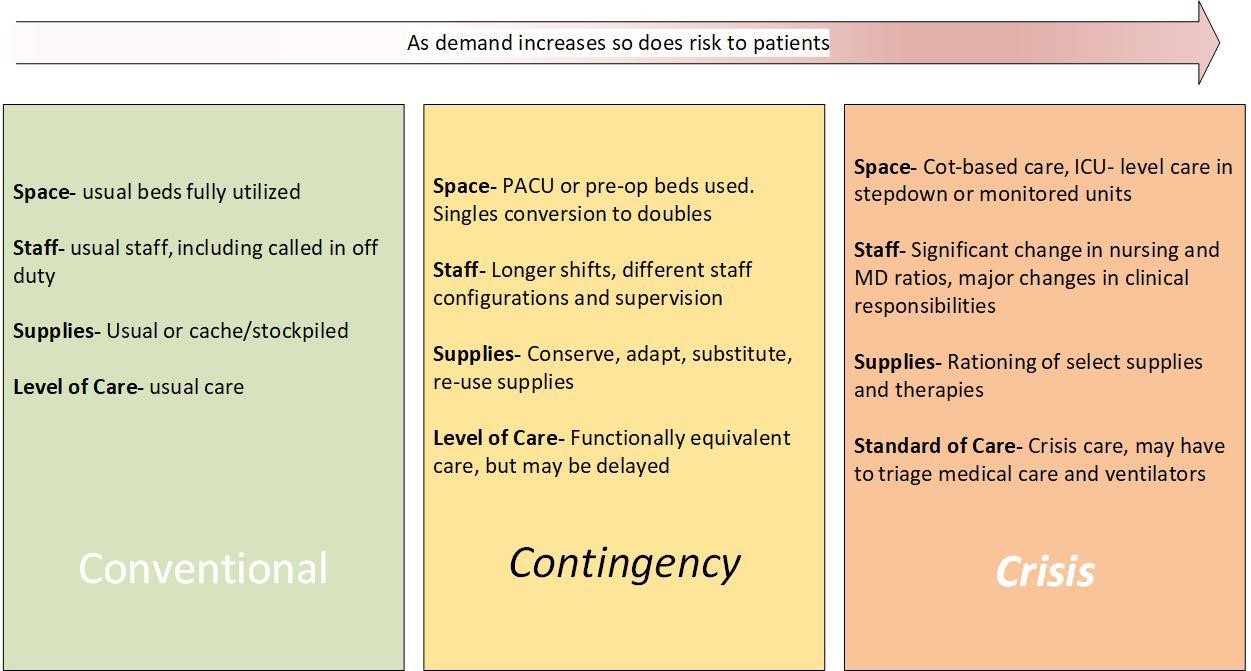California is experiencing an unprecedented and exponential surge in COVID-19 cases, and staffing and other resources are becoming strained. CDPH is outlining resources and expectations for all health facilities so that together California's health care delivery system achieves the following four goals:
- All facilities are able to remain in conventional or contingent care as long as possible.
- All facilities have prepared plans for crisis care if needed and as a last resort.
- All facilities work with other facilities, healthcare networks, local healthcare coalition, local public health, and their local Medical Health Operational Area Coordinators (MHOACs), in the area, county, region and state, to provide support needed so all California facilities can remain in contingent care as long as possible, to ensure that healthcare is delivered based on ethical principles including equity.
- The public has clear and transparent information about the crisis care continuum and facilities' approach to crisis care during this surge.
Crisis Care Continuum Guidelines
CDPH expects that all facilities have crisis care continuum guidelines and if experiencing surge (as majority of facilities currently are), are implementing those guidelines. Facilities are expected to have plans that best fit their facility and regional needs and processes, while following ethical principles, health equity goals, and civil rights laws. Facilities that do not have current guidelines should consult with their MHOACs for technical assistance. By January 6, 2021, all facilities must notify their local CDPH district office and local public health department via email that they have adopted and publicly posted (include link to posting) one of the following: their own crisis care continuum guidelines, another facility's guidelines, or the State's California Crisis Care Continuum Guidelines.
CDPH recommends all facilities review the California Crisis Care Continuum Guidelines (PDF) issued in June 2020 with particular attention to both contingent care and crisis care stages:
For each stage of the crisis care continuum, there are resources available and new expectations for facilities, in order to respond to the current surge in COVID-19 cases:

Contingent Care Implementation
Based on the severity of the surge and on facility data, California has the working understanding that all facilities are currently implementing some elements of contingency care as of the date of this AFL. Facilities may notify the State if this is incorrect for their site, and they are providing conventional standards of care. Facilities implementing contingent care should access the following resources to assist the facility to remain in contingent care and avoid crisis care until they can return to conventional care:
- Checklist of 4 key areas for contingent care. Facilities in contingent care should use the attached checklist to assist in assessing use of all possible contingencies prior to moving to crisis care. The checklist covers key components to address in emergency preparedness, using a framework based in medical ethics, including personal protective equipment, staffing, space, and operations.
- Local/Regional healthcare coalition coordination. In the setting of limited resources and strain to the healthcare delivery system, facilities are expected to actively work with their healthcare networks, local healthcare coalition, local public health, and their local MHOACs for supply, equipment, and staffing support
- Technical assistance, staffing, and other resource requests to State
Each local jurisdiction will develop a communications plan to notify the public that impacted facilities are operating under contingency care that, at a minimum, involves the impacted healthcare facilities and the local MHOAC.
Crisis Care Planning
Facilities must plan for crisis care now, both as a facility and with the county and region. Facilities should pay particular attention to planning related to the activation of triage teams for the allocation of critical care resources and following ethical and equitable principles and civil rights law in allocating scarce resources.
- Technical assistance calls should be convened at the local and regional levels. Technical assistance can also be sought through the state via a request to the CDPH district office.
Crisis Care Implementation
Facilities that need to implement crisis care, including triage of critical care resources, must notify their local public health department and local CDPH district office via email and phone call immediately when initiating crisis care to ensure the State is aware of conditions at the facility.
- This notification will serve as a warning system identifying where the State may need to provide or assist in coordinating resources or plan for transfers or diversions.
- This notification will also assist the State in ensuring California's surge response is guided by ethical and equitable principles and civil rights laws.
- If a single hospital in a county reports implementing crisis care guidelines, the state in consultation with the local health officer and MHOAC, may require resources be shared between one or more facilities and that elective surgeries be canceled along with other decompression measures (see checklist). As a reminder, both the state and local health officers have the authority to require the cancellation of elective surgeries and to require facilities to accept patient transfers.
- Each local jurisdiction will develop a communications plan to notify the public that impacted facilities are operating at crisis care that at a minimum involves the impacted healthcare facilities and the local MHOACs.
If you have any questions about this AFL, please contact your local district office.
Sincerely,
Original signed by Heidi W. Steinecker
Heidi W. Steinecker
Deputy Director
Resources: